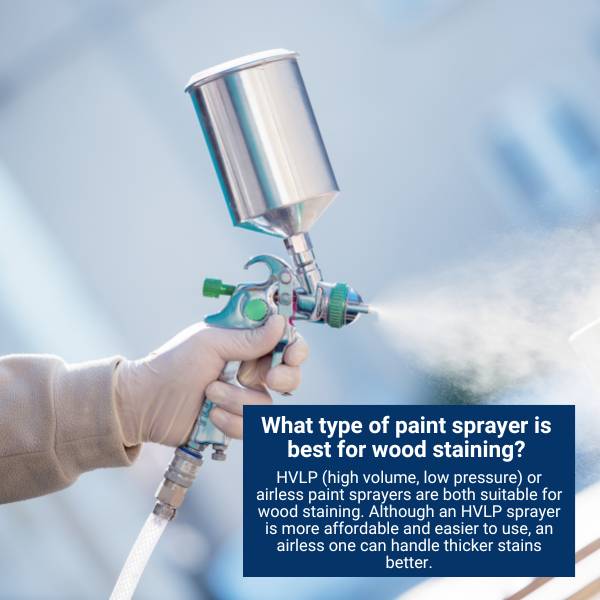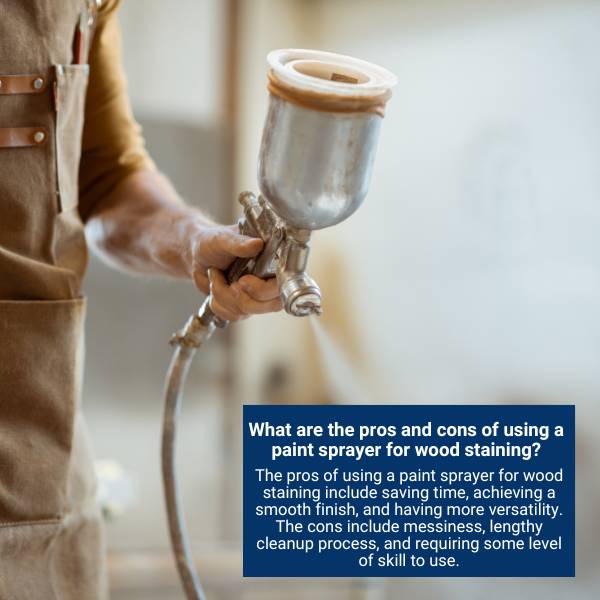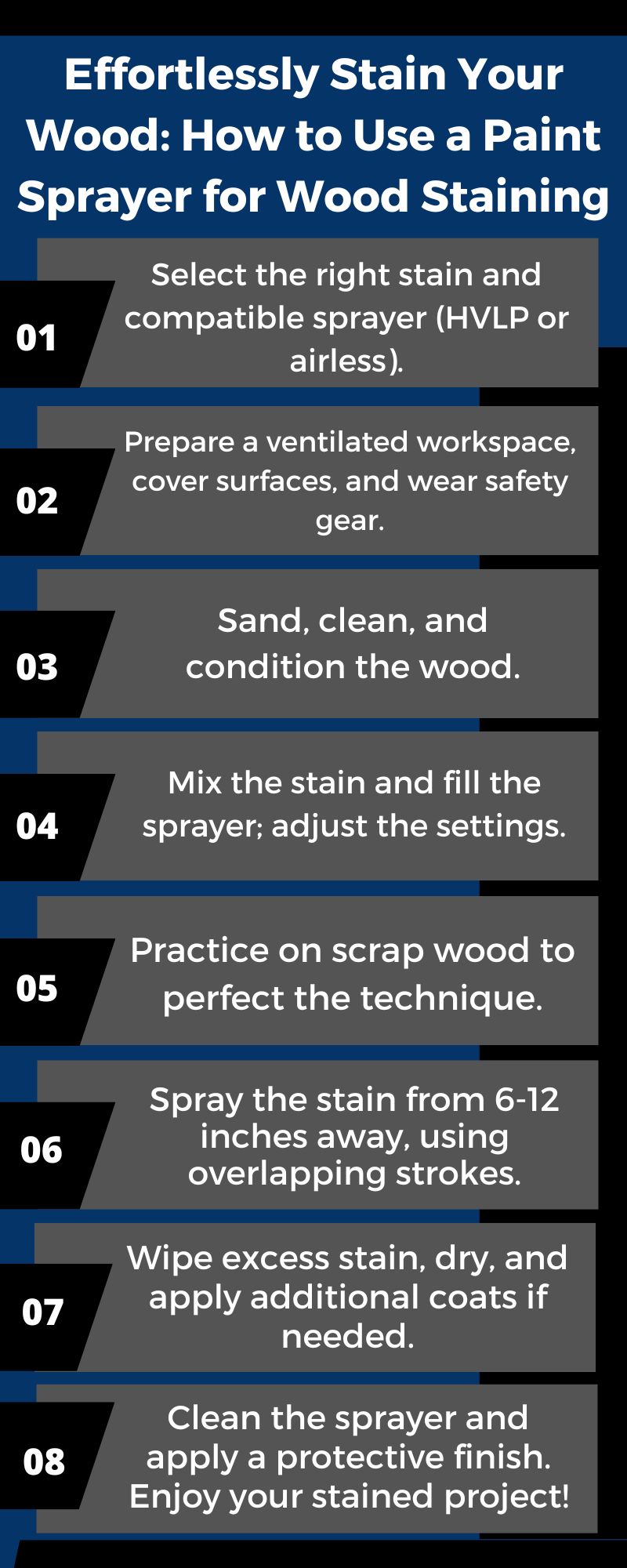Wooden furniture, decks, and rails add a beautifully esthetic touch to any home. Still, it needs proper maintenance and time-to-time paint jobs to keep it fresh for years. Besides, spraying with the sprayer is the easiest method to paint anything. Have you considered using a paint sprayer to stain your wood? Many DIYers wonder if spraying wood stains with a paint sprayer is possible.
Indeed, it is entirely feasible to apply the wood stain using a paint sprayer, provided that specific conditions and techniques are adhered to. Choose a thinner stain and the right sprayer. Wear protective gear and clean the wood surface before application.
You can achieve a beautiful, professional-looking finish on your woodworking projects with the right technique. But what about clean-up? Is it worth the investment? And what other tips should you know before you start spraying? Keep reading to find out.

Can I Use A Paint Sprayer To Spray Wood Stain:
Yes Definitely! You can use a paint sprayer to spray wood stains. It’s a fantastic idea! In addition to saving a ton of time and effort, it will give you a smooth, even finish, unlike ugly brush strokes.
Using the paint sprayer is the best way to quickly apply a beautiful coat of stain to your wooden surface. Hence, you will not have to hand-apply stains with a brush or roller and deal with messy drips and uneven coverage.
So grab that paint sprayer and transform your wooden surfaces into art. Trust me. You won’t be disappointed! But before that, let’s weigh the pros and cons of applying the stain with a sprayer.
What Are The Pros And Cons Of Using A Paint Sprayer For Wood Staining?
Using a staining technique is one of the main steps in DIY deck staining tasks. It greatly affects the results. Therefore, it’s important that if you plan to use a paint sprayer, you look into its pros and cons first. So, let’s break it down!
Pros:
Time saver: Using a paint sprayer is so much faster than applying stain by hand with a brush or roller. You can cover large surfaces in a fraction of the time it would take.
Smooth finish: When you use a paint sprayer, the stain is atomized into tiny droplets. Thus, it provides a smoother and even finishes than a brush or roller.
Versatility: It allows you to adjust the spray pattern and flow rate to achieve different effects and customize the finish.
Consistency: The stain application is much more consistent with a paint sprayer because it applies a uniform coat of stain to the surface. Hence, it eliminates the possibility of uneven coverage.

Cons:
Messy: Using a paint sprayer can be messy, especially if you’re not experienced with it. The careless application can result in overspray on surrounding surfaces. So it’s important to mask off the area properly.
Cleanup: Cleaning a paint sprayer is time-consuming and requires much effort. You must clean it thoroughly after each use to avoid clogs and ensure it’s ready for your next project.
Skill required: Using a paint sprayer requires a certain level of skill and technique to get the best results. If you’re not experienced with it, you will need a lot of practice to get the hang of it.
What Type Of Paint Sprayer Is Good To For Wood Staining?
A few different types of paint sprayers can be used for wood staining. However, generally, you should look for a sprayer with a fine finish tip or nozzle and easy cleaning. It will allow you to apply the stain in a thin, even coat while reducing the cleaning time. So, let’s see which paint sprayer is good for staining wood.
Either you can use an HVLP sprayer to stain your deck or an Air pressure spray HVLP (high volume, low pressure) sprayer has a compressor to atomize the stain and produce a fine mist easily applicable on the wood surface. They are also relatively affordable, which makes them a popular choice for DIYers.

In contrast, you can use airless paint sprayers. It uses a high-pressure pump to force the stain through a small nozzle. Hence, it is better suited for larger projects or thicker stains. However, it can be more challenging and requires more preparation and cleanup. So, whichever you pick, make sure you patch-test it first.
What Are The Important Tips And Tricks For Applying Wood Stain Using A paint Sprayer?
Applying wood stain with a paint sprayer can be a game-changer when achieving a smooth, even finish. However, a good technique can save it. Here are some important tips and tricks that will help you achieve noticeable results:
Prep Your Surface:
You must ensure your surface is clean, dry, and dust free. Try sanding it down to create a smooth surface for the stain to adhere to.
Choose The Right Stain:
Not all stains are suitable for use with a paint sprayer. Look for thin stains to spray easily, and don’t clog the sprayer nozzle.
Test Your Sprayer:
Before starting your project, do a test spray on a scrap piece of wood to ensure your sprayer is working properly, and adjust the flow rate and spray pattern if necessary.
Use A Quality Sprayer:
Invest in a high-quality sprayer that’s designed for use with stains. Cheap sprayers can lead to uneven application and are more prone to clogging.

Protect Surrounding Surfaces:
Cover any surfaces or areas around your project that you don’t want to get a stain on with masking tape or plastic sheeting.
Spraying Technique:
Hold the sprayer consistently from the surface and move it smoothly and sweepingly. Ensure overlapping each pass slightly with the other for even coverage.
Work In Sections:
Work in small sections, overlapping each pass slightly to ensure even coverage. It will prevent the stain from drying before you can even it out.
Apply Multiple Coats:
Depending on the desired finish, you may need multiple coats of stain. Allow each coat to dry completely before applying the next.
Clean Your Sprayer Thoroughly:
Follow the manufacturer’s instructions to prevent clogs and ensure it’s ready for your next project after each use.
Final Verdict:
Using a paint sprayer to apply wood stain is a viable option that can offer numerous benefits over using a brush or roller. However, it’s important to thin the stain to the right consistency to avoid clogging the sprayer and to take the time to learn the proper technique to achieve the best results.
It can save time, create a smooth finish, and provide versatility and consistency. However, you must consider the potential drawbacks and take precautions to avoid making a mess or damaging surrounding surfaces. Hence, with the right approach and practice, you can use a paint sprayer to achieve a beautiful, professional-looking finish on your wood staining projects.

